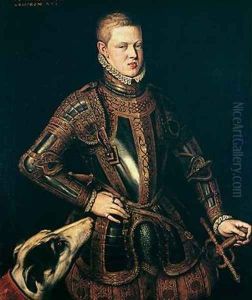Cristovao do Moraes Paintings
Cristóvão de Morais, sometimes seen as Cristovao do Moraes, was a prominent Portuguese painter active during the 16th century. Born in 1516, Morais is best known for his work as a portraitist at the court of King John III of Portugal and later, King Sebastian. Unfortunately, detailed records of his life, training, and early career are scarce, which is common for many artists of this period.
Morais likely received his artistic training in Portugal and may have been influenced by foreign artists who were active at the court or by the works of other European painters that were available in Portugal at the time. His style is characterized by a strong sense of realism and attention to detail, attributes that made him a favored artist among the nobility.
His most famous work is the portrait of King John III, which showcases the king in a solemn and authoritative manner. Morais's ability to capture the likeness and character of his sitters earned him a significant reputation. He became the official court painter, a prestigious position that allowed him to receive numerous commissions from the royal family and high-ranking nobles.
Morais's works are considered important for the study of Portuguese Renaissance art. They provide not only an insight into the aesthetics of the period but also into the social and political hierarchies of the time, as his portraits often depicted individuals of status and power.
Despite the esteem in which he was held during his lifetime, Cristóvão de Morais remains a somewhat obscure figure in the broader context of European art history. His death in 1573 marked the end of a career that had a lasting impact on the development of portrait painting in Portugal, influencing subsequent generations of artists in the region. His works are held in various Portuguese museums and are considered national treasures.
